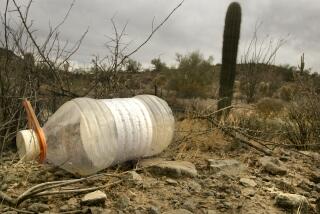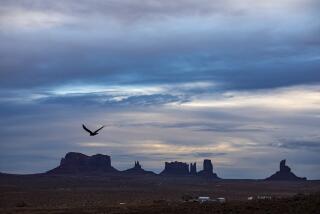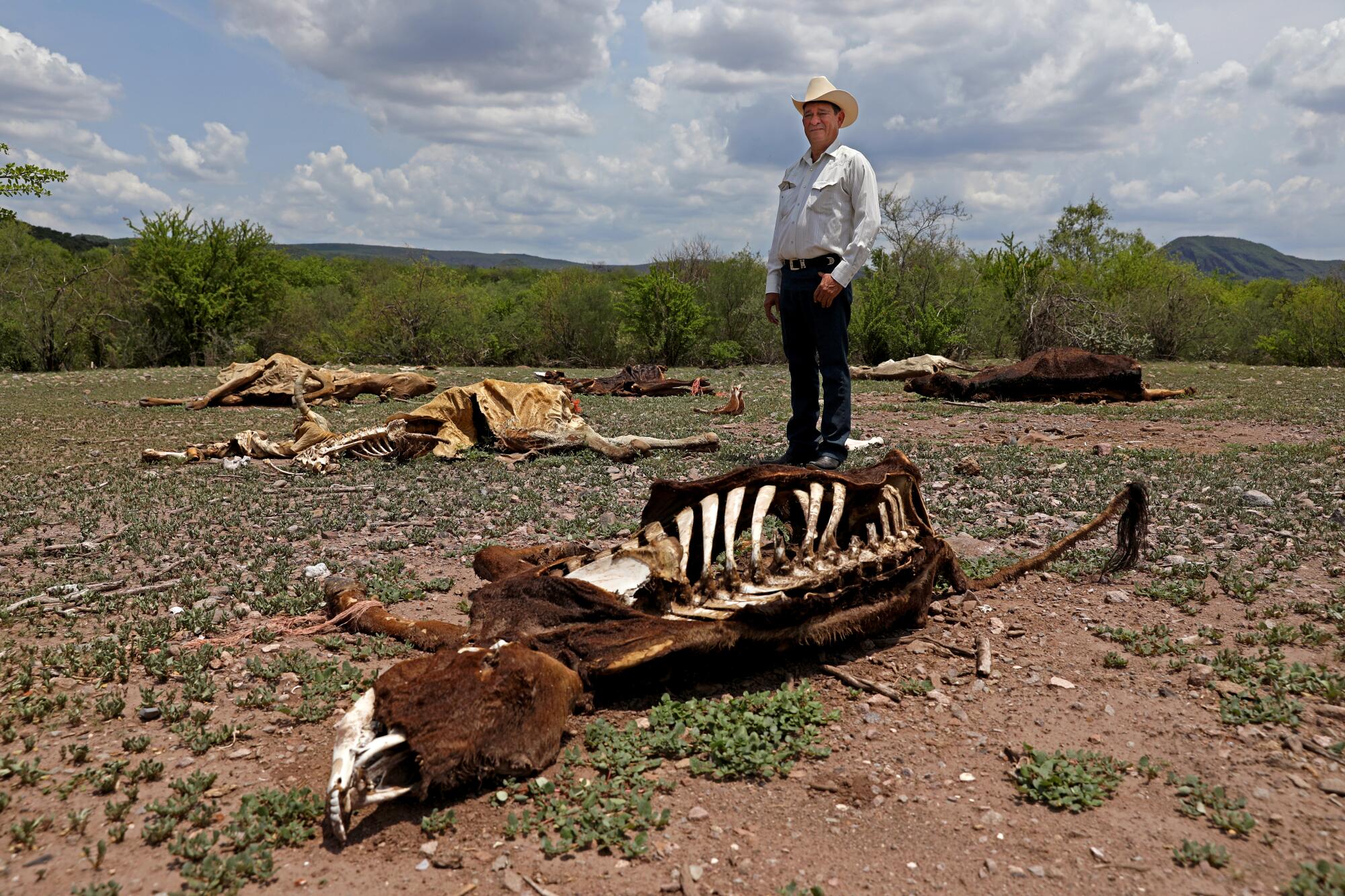
- Share via
CAJEME, Mexico — In the parched hills of southern Sonora, Marco Antonio Gutierrez paced around a clearing, counting the dead.
There were seven rotting carcasses — jutting ribs and shriveled hides — and two sun-bleached skulls. Nine cows, felled by heat and hunger.
“There’s nothing for them to eat,” said Gutierrez, a wide-brimmed hat shading his downcast eyes. “There used to be big ranches here. Now it’s pure sorrow.”
Two years of extreme drought have turned large stretches of northern Mexico into a boneyard. Between starvation and ranchers forced to prematurely sell or slaughter their livestock, officials say the number of cattle in Sonora has dropped from 1.1 million to about 635,000.
It’s an unimaginable loss for a state that is world-famous for its high-quality cows, and where beef is not just a central part of the diet and economy but also a tradition that binds families together.
This is a place, after all, with a bull on its state flag, and where families gather every Sunday around their charcoal grills. Red meat is considered a birthright: It’s not uncommon for folks here to eat beef three times a day — machaca scrambled with eggs for breakfast, arrachera for lunch and carne asada for dinner.
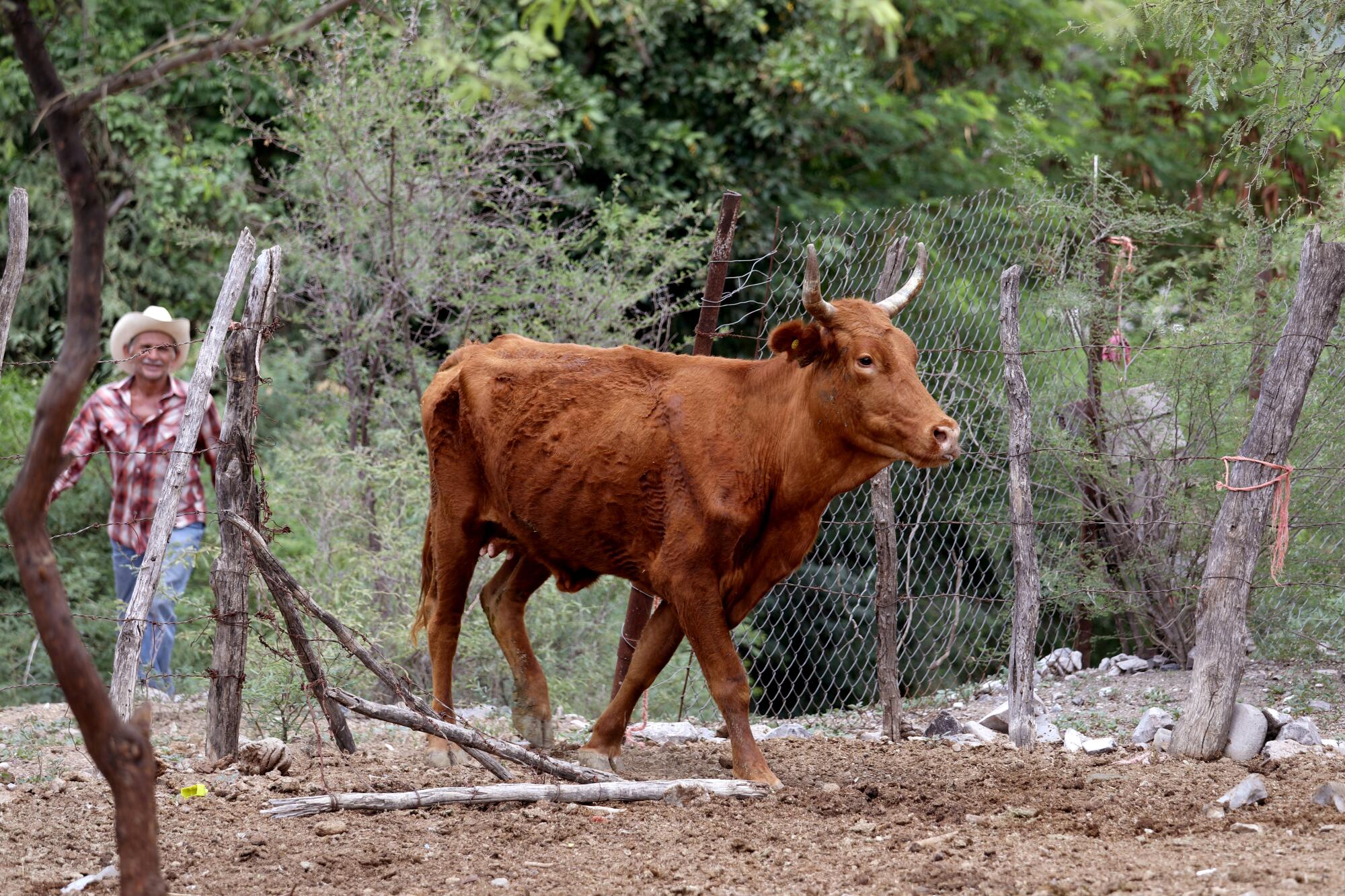
Gutierrez, 55, and pretty much everyone he knows was born ranching. By the age of 10, he and his friends had all learned from their fathers how to lasso, brand and even pull a calf from the womb.
Now, as they desperately watch the skies for rain, they wonder if there’s any future in it.
Gutierrez doesn’t use the phrase “climate change” to describe what’s happening, but he laments that every year seems drier and hotter than the last. In recent months, he has watched helplessly as 70 of his 100 cows have starved to death.
Over coffee and machaca at a restaurant owned by fellow rancher Julio Aldama Solis, the two friends mulled whether it was finally time to auction off their remaining cattle — or whether they should keep struggling.
Selling would be heartbreaking, Aldama said, a surrender not only of their cowboy identity but also their family legacy.
“Imagine the sadness — all the sacrifices of your grandparents and your parents for nothing,” said Aldama, the 56-year-old scion of a prosperous ranching family in the largely rural county of Cajeme.
Gutierrez sipped his coffee. There was a reason he had held on to his herd during the worst of the drought, even as the animals wasted away in front of him.
It was his father, long dead, who had taught him the arduous but rewarding ways of ranch life.

And Gutierrez had come to love his cattle, even giving names to some: Coyota, La Venada, Vellota.
They had lived alongside his own family, and had helped sustain it financially. Every year the cows birthed calves that he could sell for about $600 each at auction.
At least now they were free from the misery of drought.
“They passed on to a better life,” he said.
‘THEY’RE DRY. COMPLETELY’
The cicadas were humming. That was a good sign.
Some people in these parts believe the buzz of cicadas — like the tambourine shake of a rattlesnake — means a thunderstorm is rolling in.
Gutierrez and Aldama scanned the sky. The sun was beating down, hot as ever, but a few cotton-like clouds loomed on the horizon.
“We’re all praying to the Virgin of Guadalupe that it rains,” Aldama said.
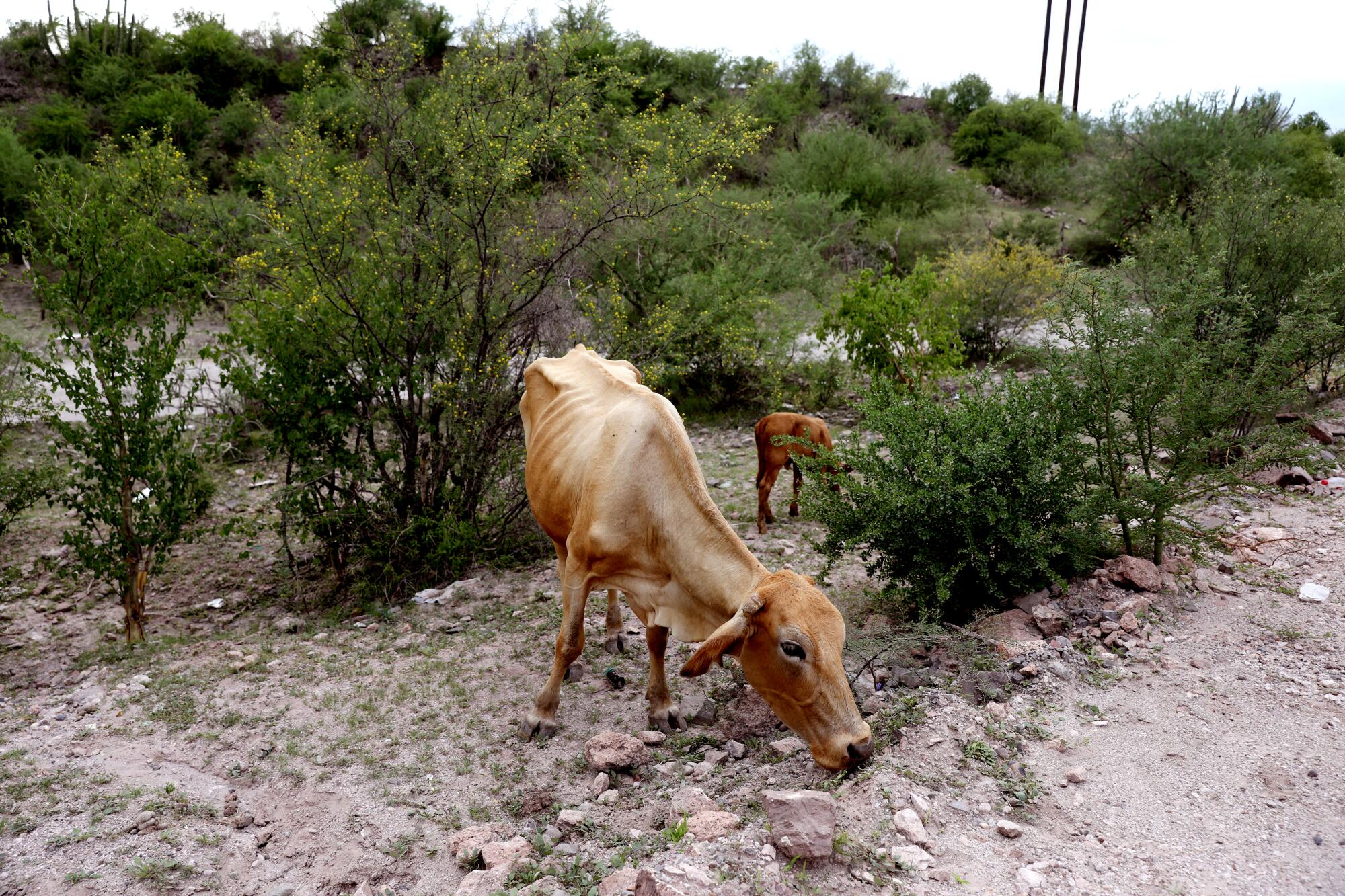
They were touring the region’s ranches with another friend, Ricardo Alcala, who is the president of the Local Livestock Assn. of the Yaqui Valley. All three wore jeans with silver buckles and white cowboy hats.
There had been a couple of big storms in other parts of the state — enough to cause flooding in the border city of Nogales. Yet 97% of municipalities in Sonora remained officially in drought, and while sporadic rain here in the south had greened up the mesquite trees that dotted the landscape, it had not been enough to make grass grow.
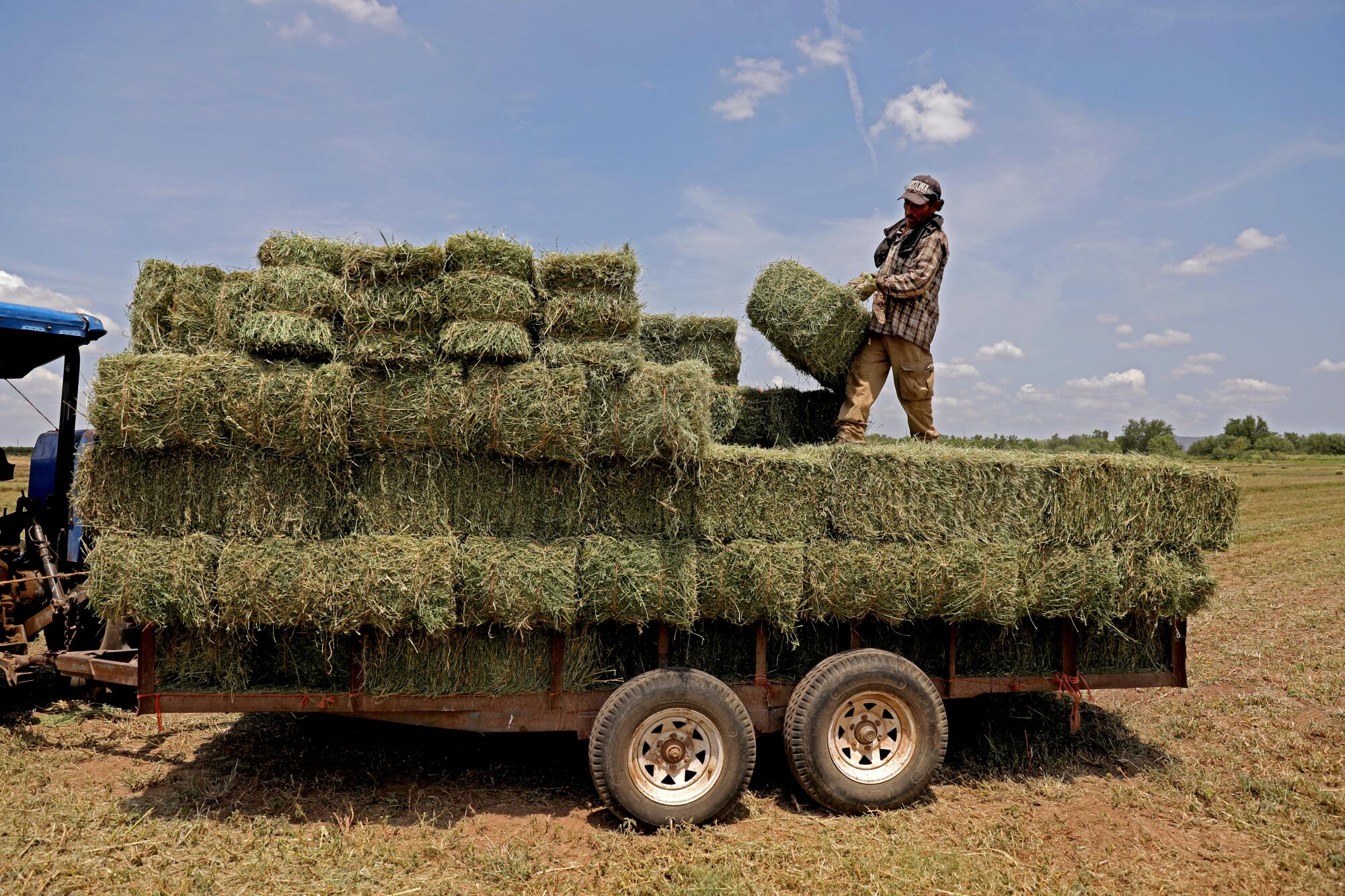
It wasn’t even noon yet, and the thermometer on Alcala’s truck read 104 degrees. As the friends drove, they passed people shielding themselves from the sun with umbrellas, and dogs and horses hugging the sides of buildings, desperate for shade.
And then there were the cattle, thousands of them, some so skinny they looked like skeletons wandering the hills.
For months, ranchers had depended on alfalfa grown in fields irrigated with water from private wells or a nearby dam. But when the dam levels fell dangerously low, authorities had cut off the supply to ranches and farms to conserve water for drinking, cooking and bathing. The price of alfalfa had doubled — putting it out of reach for many.
Alcala’s organization had pleaded with authorities to drill wells in the region so ranchers could grow their own food for their cattle. But water table levels have fallen too, making it clearer each day that wells are at best a temporary solution.
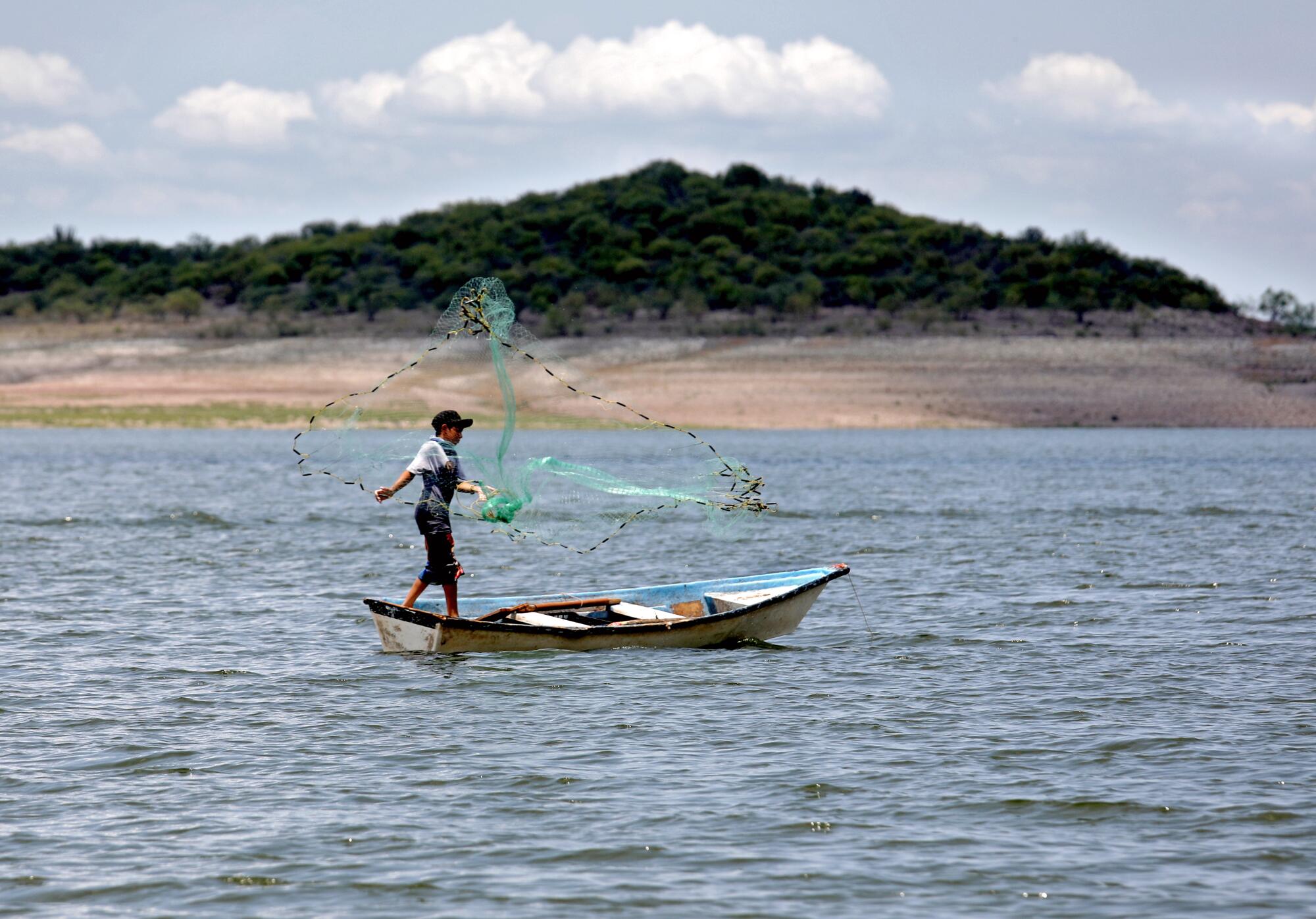
Alcala pumped the brakes of his Ram truck when he saw a member of his association, Jesús Arvizu Valenzuela, cutting hay in a field that stood out for its lushness. But Arvizu, 68, told him the pasture would soon lie fallow — brown like the unirrigated land that surrounded it.
“They won’t give us water anymore,” he said.
“The wells aren’t working either?” Alcala asked.
Arvizu shook his head. “They’re dry. Completely.”
‘A MATTER OF IDENTITY’
Five hundred years ago, there were no cattle here.
The first cows were brought to Mexico by Spanish conquistadors in the 1500s. In Sonora, Jesuit missionaries encouraged Indigenous tribes, who had subsisted mostly on beans, corn and squash, to raise them.
By the second half of the 20th century, livestock had become big business here, with cattle roaming over 85% of the state. Tens of thousands of ranchers raised steers to sell at auction, many for export to the United States. Ranchers here say Sonora’s mix of native grasses give their beef a distinctive texture.
“Very juicy and soft,” Alcala proudly explained.
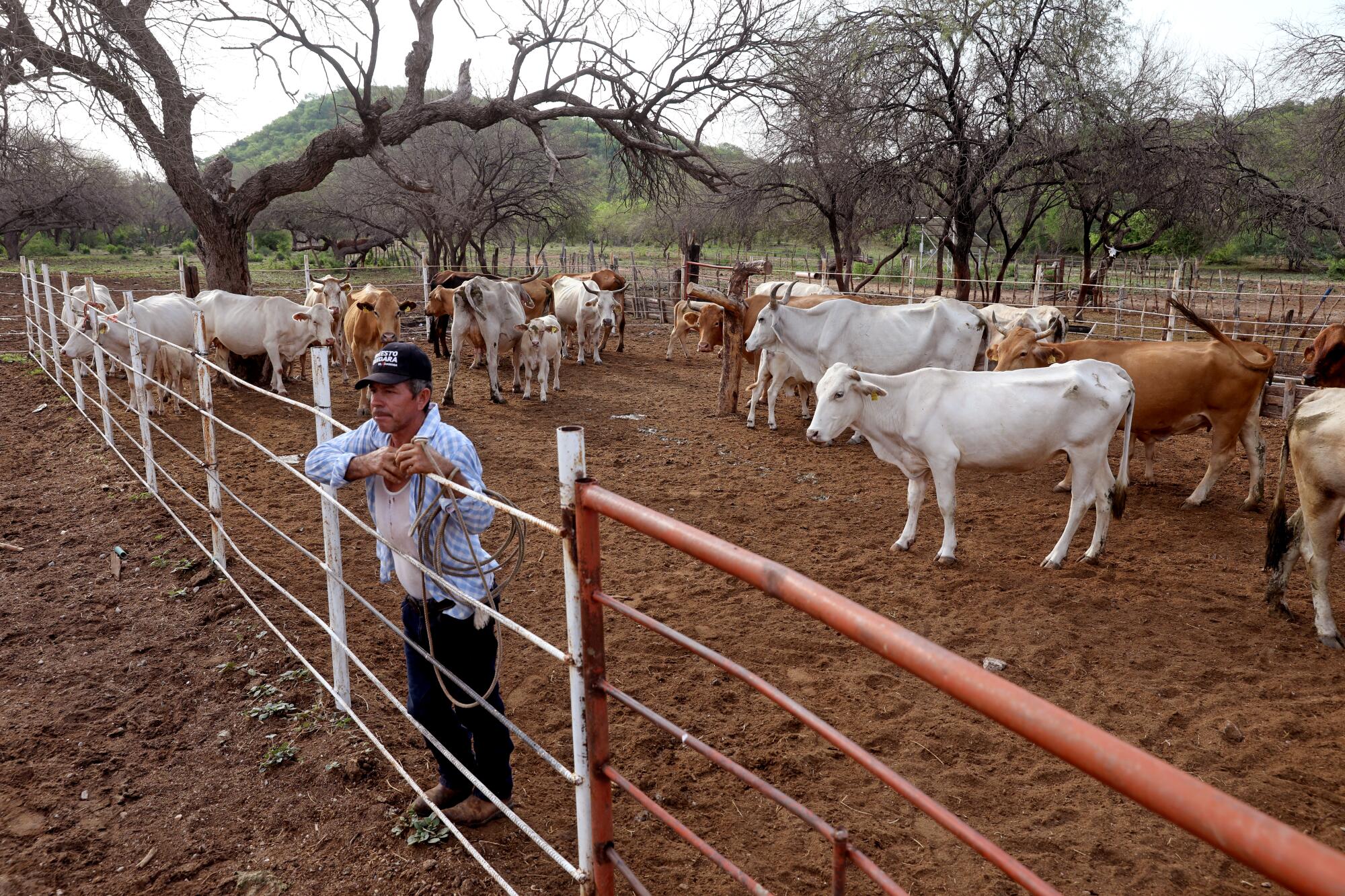
There were always periods of drought that ranchers had to endure — but in recent decades, climate change has made things worse.
Average rainfall has been decreasing for years. By the second half of this century, climate experts predict that Sonora will receive 20% to 30% less rain than today and regularly see temperatures as high as 122 degrees.
América Lutz Ley, a social scientist at El Colegio de Sonora who studies land use, is one of a growing number of people in the state who believe cattle ranching in its current form is not sustainable, largely because of the huge amount of water required to grow food for the herds.
“We live in a desert yet we are in the business of exporting water in the form of livestock,” she said.
Then there’s the fact that cattle emit significant levels of methane, a major driver of global warming. Mexico’s 34 million cattle are responsible for about 10% of the nation’s total greenhouse gas emissions.
Lutz wishes there was more political will to promote alternatives to ranching. But she acknowledges that major changes are unlikely as long as prices for steers remain high and beef continues to be “a matter of identity” in Sonora.
She grew up spending weekends at carne asadas eating flour tortillas stuffed with salsa, guacamole and thin cuts of charred beef. It’s a family ritual so beloved here that even Lutz still indulges in it.
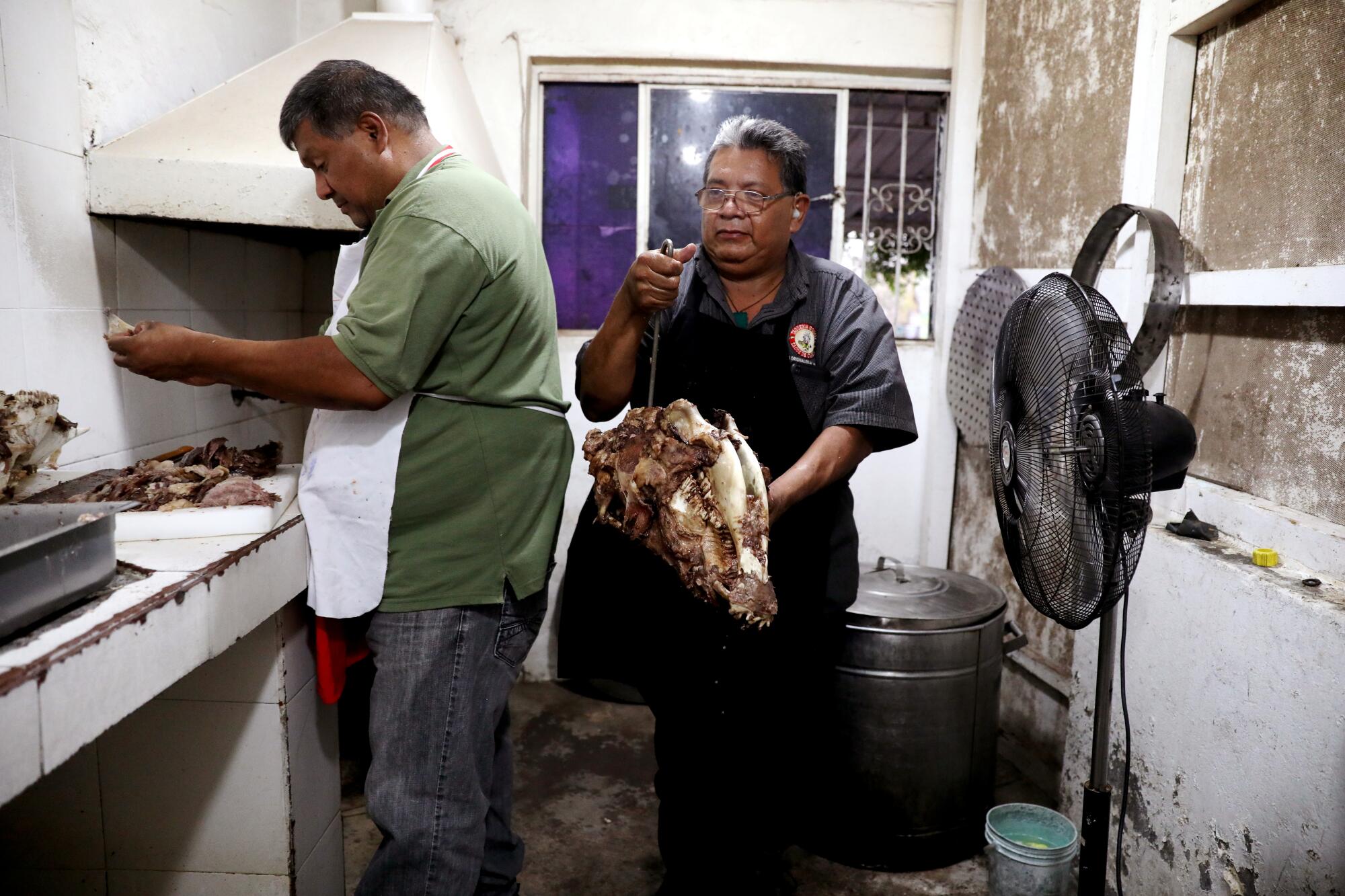
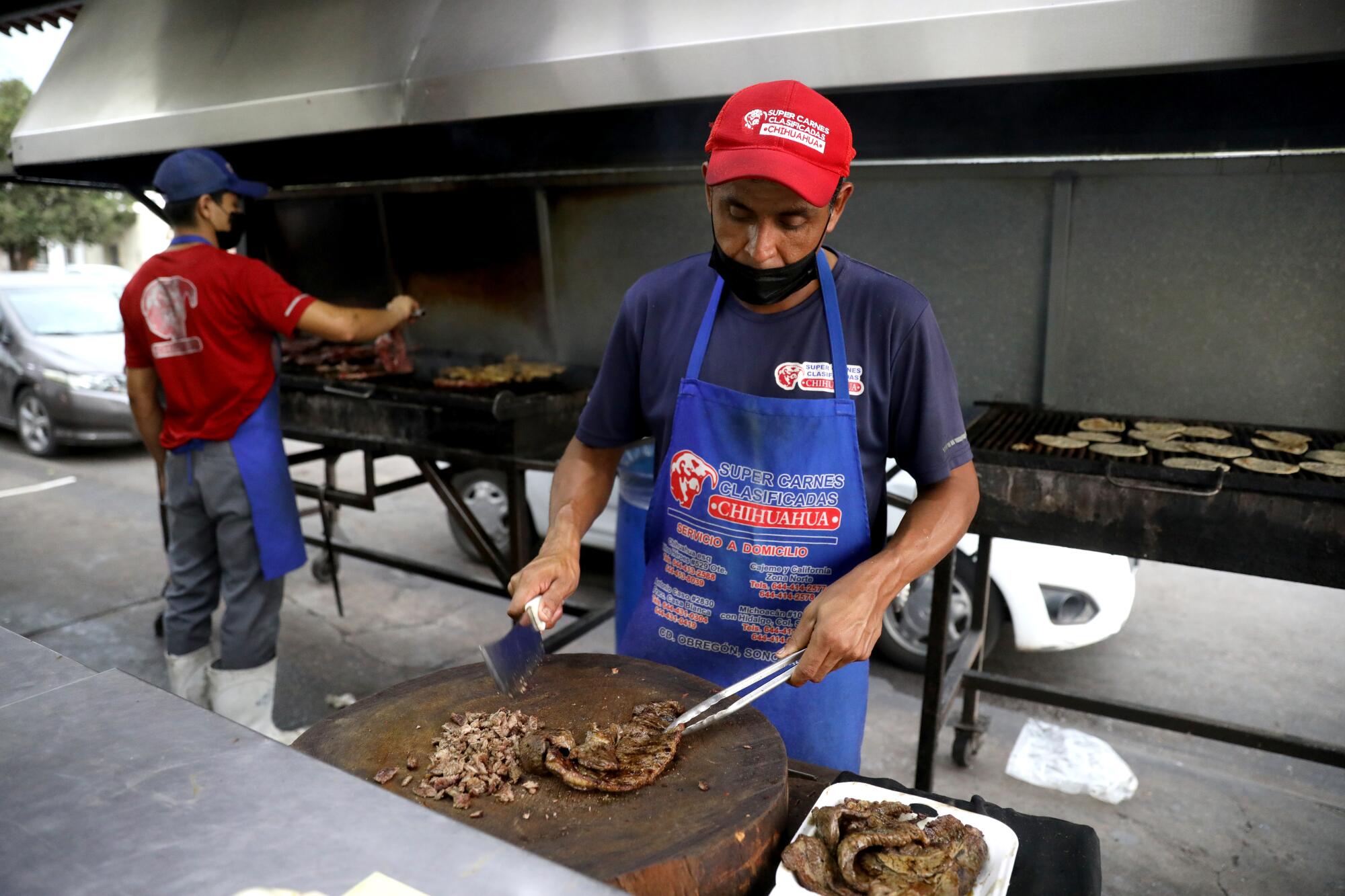
It’s not easy changing culture.
Gutierrez knows that. For him and his friends, ranching is more than a livelihood — it’s a way of life.
As they drove on, the sky began to darken. A few fat raindrops hit the truck’s windshield. It seemed the cicadas had been right.
Alcala optimistically turned on his wipers. But a minute later, the rain stopped and he turned them off.
A PAINFUL DECISION
Early the next morning, Gutierrez and his two friends crowded into a different pickup, this time to check on Aldama’s ranch.
The sky was pink with sunrise. The radio was playing an accordion-heavy corrido about three brothers on horseback setting off at dawn to a party on a ranch.
As they turned off the highway onto Aldama’s property, Gutierrez exclaimed with delight.
“It rained, Julio!”
The storm they had driven through the day before had been more generous in this region. Butterflies flitted about orange and pink wildflowers that appeared to have bloomed overnight.
“It’s green and fresh and I’m happy because it rained,” said Aldama as his Chevy splashed through scattered puddles.
But he knew that one decent rain wouldn’t be enough.
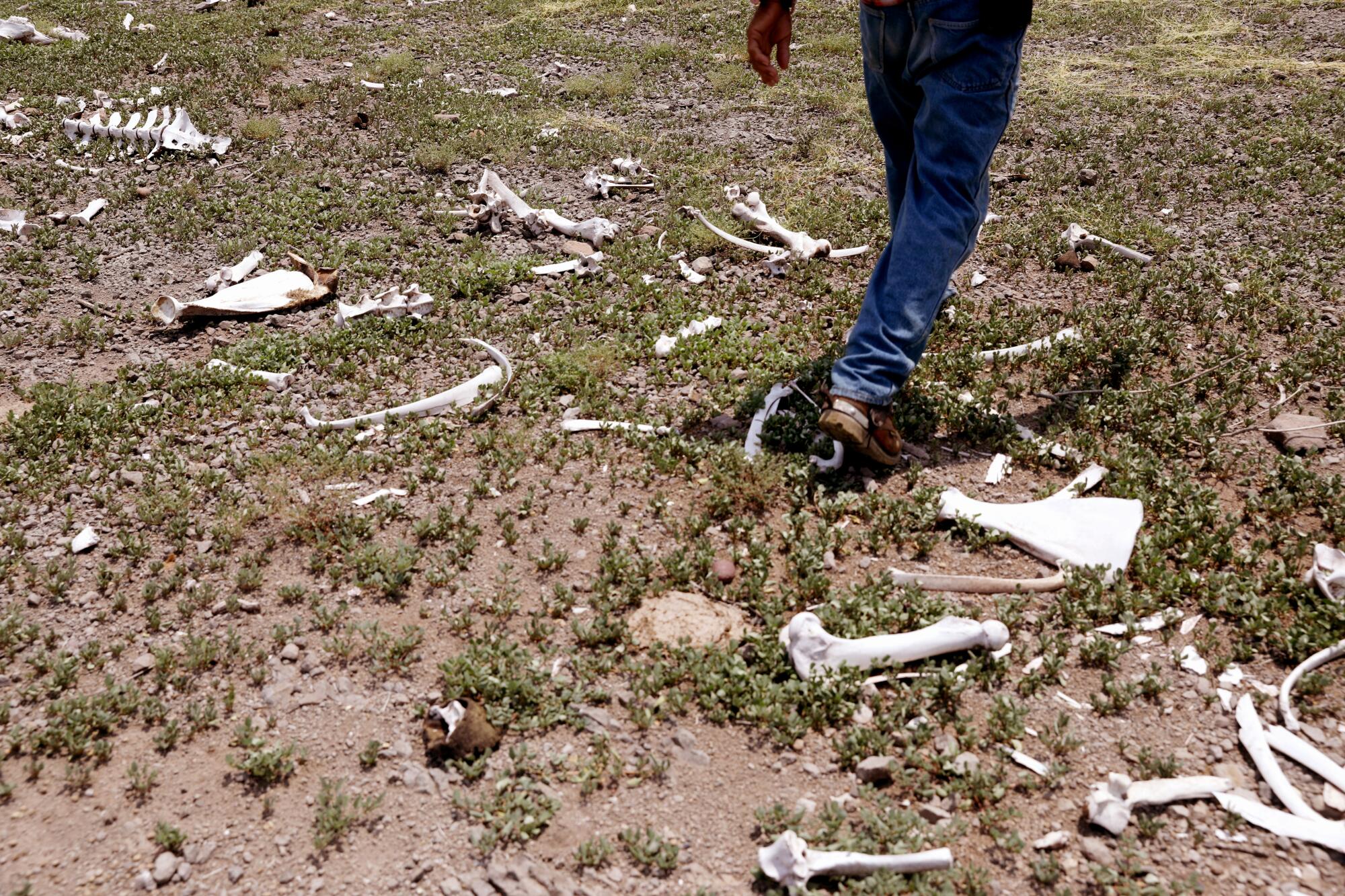
“The ranch is still in crisis,” Aldama said. “There’s no grass.”
He signaled to a field where a month ago his son and some friends had planted sorghum for his animals.
Weeks later, the field was barren except for the empty cans of Bud Light the young men had downed after finishing their work.
“It should have been a foot high by now,” Aldama said. “We planted sorghum but only beer has grown.”
They came to a pen where a ranch hand was milking cows. During the hottest months of the drought, Aldama had kept most of his cattle alive by feeding them carrots he had grown on another plot he owned.
He proudly appraised the half dozen calves, some just a few weeks old, that were competing with the ranch hand to get milk from their mother.
But selling all of the calves in a few months wouldn’t make up for the costs of keeping his herd alive, he said.
His grandparents founded this ranch, growing it from just a few cattle to a lucrative business. Lately their descendants had been talking, and had recently come to a painful decision.
Unless there are recurring, penetrative rains in August, the family will sell half of its herd. Where the cow pastures once grew, they are thinking about planting agaves — which require little water and are used to make a stiff local liquor called bacanora.
“I don’t see a future in ranching,” Aldama said, his voice cracking. “It’s a really good business when it rains, but lately it’s all losses.”
But the power of tradition is strong. Stronger, sometimes, than reason.
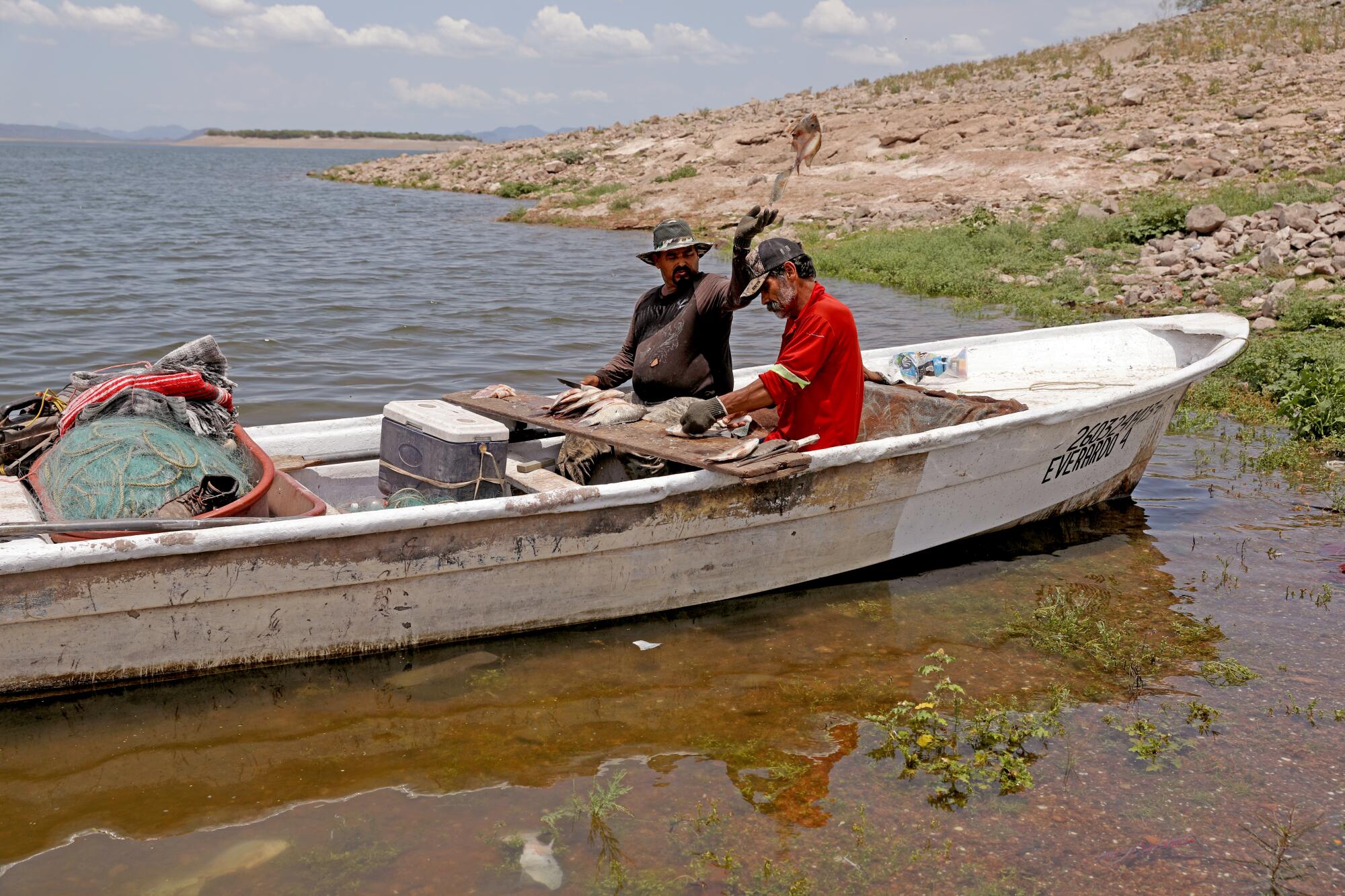
Gutierrez did everything he could to keep feeding his cows. To raise money, he started buying and selling tilapia and carp caught from the local dam. But that business tanked as the dam nearly went dry.
He and his wife, who works at a hospital, have decided that their two children should not have to endure such hardships. They are studying in Ciudad Obregon, the nearest city.
“I suffered a lot and I don’t want them to suffer,” Gutierrez said.
He still doesn’t know what he’ll do — try to rebuild his herd or give up.
On a recent hot afternoon, he was commiserating with Manuel Bustamante Parra, a 58-year-old friend in similar straits.
Bustamante used to have 28 cattle, but now has 19. He did his best to save the hungry animals in their final days — using a rope-and-pully system to haul them upright to eat when they were too weak to stand — but it wasn’t enough.
Every few days, Bustamante rides his horse to a different small chapel in the region. He asks for rain as he lights candles to the Virgin of Guadalupe. He and Gutierrez have been traversing these hills on horseback for as long as they can remember.
“I’m too old to learn something new,” Gutierrez said.
“We’ll keep ranching until all the cows die,” Bustamante told him. “Or we do.”
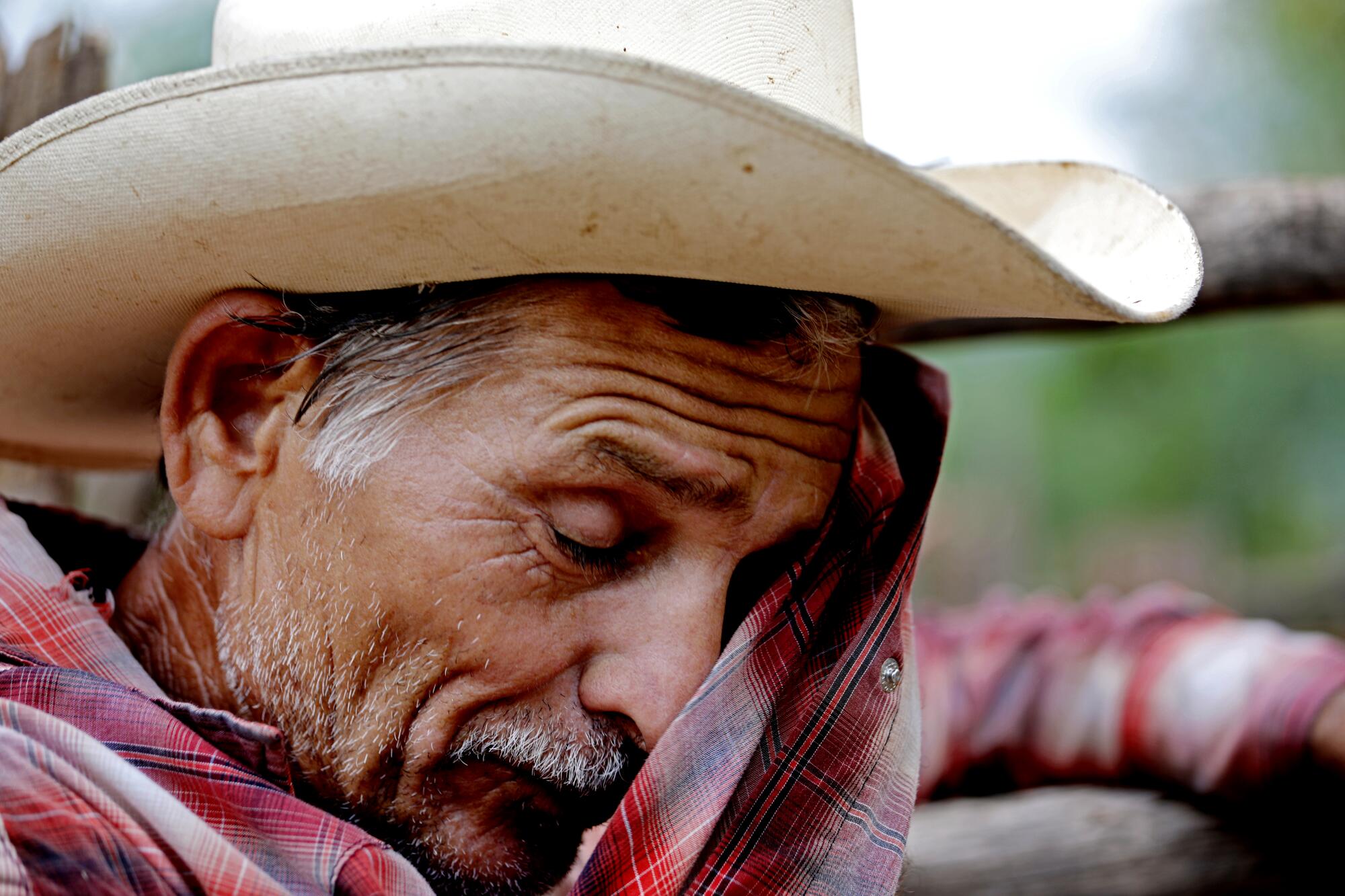
Cecilia Sánchez in The Times’ Mexico City bureau contributed to this report.
More to Read
Sign up for Essential California
The most important California stories and recommendations in your inbox every morning.
You may occasionally receive promotional content from the Los Angeles Times.


